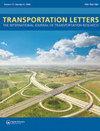从服务-物理依赖的角度重新审视总线网络的健壮性
IF 3.3
3区 工程技术
Q2 TRANSPORTATION
Transportation Letters-The International Journal of Transportation Research
Pub Date : 2025-09-14
DOI:10.1080/19427867.2025.2470543
引用次数: 0
摘要
本研究通过解决公共汽车服务网络对底层物理道路网络的依赖性,重新审视了公共汽车网络的鲁棒性。一种新的方法将阻力距离理论与多层物理服务网络框架相结合,考虑了道路层和绕行机制的中断。引入了两个鲁棒性指标:量化中断总体影响的绝对阻力鲁棒性指标和反映网络冗余的相对阻力鲁棒性指标。利用来自29个城市的数据进行实证分析,发现地理和社会经济因素显著影响公交网络的稳健性,GDP越高、地形越平坦、城市集中地区相对稳健性越强。敏感性分析认为地形密实度是最重要的影响因素。该方法促进了对交通网络弹性的理论认识,并为城市交通规划提供了实用工具。未来的研究可以将方法扩展到定向网络,并将旅行需求数据纳入更精确的分析。本文章由计算机程序翻译,如有差异,请以英文原文为准。
Revisit bus network robustness from the perspective of service-physical dependency
This study revisits bus network robustness by addressing the dependency of bus service networks on the underlying physical road network. A novel methodology integrates resistance distance theory with a multilayer physical-service network framework, accounting for disruptions at the road layer and detour mechanisms. Two robustness indices are introduced: the absolute resistance robustness index, which quantifies the overall impact of disruptions, and the relative resistance robustness index, which reflects network redundancy. Using data from 29 cities, the empirical analysis reveals that geographical and socioeconomic factors significantly influence bus network robustness, with higher GDP, flatter terrains, and concentrated urban areas associated with greater relative robustness. Sensitivity analysis identifies terrain compactness as the most influential factor. This methodology advances the theoretical understanding of transportation network resilience and provides practical tools for urban transportation planning. Future research could extend the approach to directional networks and incorporate travel demand data for more refined analyses.
求助全文
通过发布文献求助,成功后即可免费获取论文全文。
去求助
来源期刊

Transportation Letters-The International Journal of Transportation Research
TRANSPORTATION SCIENCE & TECHNOLOGY-
CiteScore
6.40
自引率
14.30%
发文量
79
审稿时长
>12 weeks
期刊介绍:
Transportation Letters: The International Journal of Transportation Research is a quarterly journal that publishes high-quality peer-reviewed and mini-review papers as well as technical notes and book reviews on the state-of-the-art in transportation research.
The focus of Transportation Letters is on analytical and empirical findings, methodological papers, and theoretical and conceptual insights across all areas of research. Review resource papers that merge descriptions of the state-of-the-art with innovative and new methodological, theoretical, and conceptual insights spanning all areas of transportation research are invited and of particular interest.
 求助内容:
求助内容: 应助结果提醒方式:
应助结果提醒方式:


